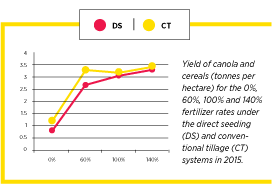Soil test to optimize yield, profit and fertilizer efficiency
Soil testing limits unknown and maximizes known factors to help growers and agronomists make more accurate fertilizer rate decisions. It is part of 4R Nutrient Stewardship.
“Effective soil test-based fertilizer recommendations should consider both the current pool of available nutrients present at seeding and the potential supply of nutrients from soil during the growing season,” says Kabal Singh Gill, a research consultant with SARDA Ag Research in the southeast Peace Region.
Gill led a multi-year study titled Assessing current soil test based fertilizer recommendations for direct seeding systems to optimize crop production and contribution margin. The study investigated the effects of different soil test-based fertilizer rates and seeding systems (direct seeding and minimum tillage) over six growing seasons (2010 to 2015). Fertilizer rates (of nitrogen, phosphorus, potassium and sulphur) were 0, 60, 100 and 140 per cent of the soil test recommendation, in a canola-cereal (wheat or barley) rotation, based on annual soil tests for depths of 0-6” and 6-12”.

Key findings and recommendations based on the results, include:
1
Soil tests detected large differences in residual nitrate (NO3-N) nitrogen, available phosphorus, extractable potassium and sulphate sulphur concentrations following years when below normal rainfall resulted in low crop yields (such as in 2010 and 2014), and where higher fertilizer rates were used. Soil tests can indicate these residual nutrients in each field, helping growers to to optimize fertilizer rates and potentially save costs in certain years.
2
Soil samples collected in the spring 2016 indicated increased stratification of some nutrients and soil properties from higher fertilizer rates. These trends were more evident under the direct seeding than the minimum tillage system. Organic matter content and phosphorus concentration declined with depth, while pH, calcium and magnesium increased with depth, and the change with depth tended to be greater at the 100% than 0% fertilizer rate. No change in stratification of NO3-N and sulphate sulphur was noticed as a result of fertilizer rates. Implications: Fertilizer addition can result in increased stratification of some nutrients and soil properties. Attention may be needed to add liming materials when high fertilizer rates are used.
3
The type of seeding system did not affect residual nutrients in the 0-6” soil depth. However, the seeding system with reduced tillage intensity had a greater positive impact on soil aggregate stability than fertilizer rate. Implications: Reducing tillage intensity can improve soil aggregation.
4
Compared to 0 per cent fertilizer rates, the relative seed yields at 60, 100, and 140 per cent rates increased with years of fertilization. Single year fertilizer use efficiency data (for the application year only) may be underestimating fertilizer benefits, since some nutrients were recycled in the soil for subsequent crops and fertilizer effect on crop yield was enhanced with multiple years of use. Recommendation: Fertilizer addition not only benefits current crop, it also benefits the subsequent crops. Use long term nutrient use efficiency data (including soil test data) to provide a better estimation of soil nutrients in a field and have more accurate fertilizer rate recommendations.
For more details, see the full project summary, final report, three published journal articles and related blog at canolaresearch.ca.




